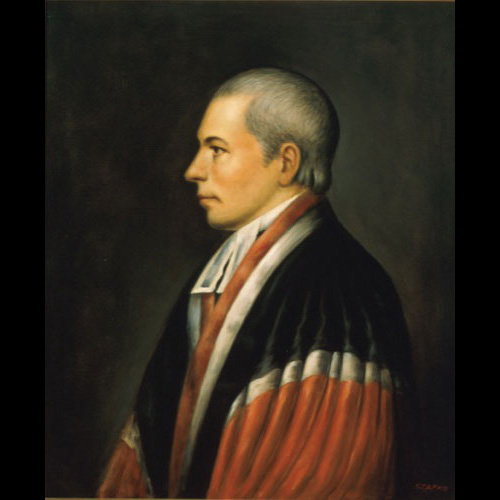
On St. Patrick’s Day we are spotlighting the only justice born in Ireland, and one of only six members of the Court born on foreign soil. William Paterson (who served from 1793-1806) came to British America from County Antrim, just north of Belfast, where his father, Richard, was a tinplate worker. In 1747, when William was two years old, the family set sail from Londonderry and landed in Newcastle, Delaware. Richard worked as a traveling peddler of tinplate in Connecticut before settling in Princeton, N.J., where the family set up a general store catering to students and faculty of the College of New Jersey (now Princeton University). The Patersons worshipped at the Presbyterian Church in Princeton.
William performed menial tasks in the store but benefited from proximity to a great academic institution. His tutor was no less than Aaron Burr, who prepared him well in Greek and Latin: William was accepted to the college in 1759. His father had saved enough money from shrewd investments in local real estate to pay for his fine education. The future Associate Justice shared classes with the future Chief Justice Oliver Ellsworth, whom he later joined in drafting the Judiciary Act of 1789, which outlined the requirements for the Supreme Court.
William Paterson would have an extraordinary impact on the fledgling nation between the time he became a lawyer in 1769 and was appointed to the Supreme Court in 1793. Representing New Jersey, he served as a delegate to the Constitutional Convention where he distinguished himself by proposing the New Jersey Plan (also called the Paterson Plan). Drafted by representatives from a number of small states, the plan called for equal representation by state rather than by population. The controversial proposal caused an impasse, which Paterson helped break by forging a compromise that called for different representation in the House and Senate. A Georgia delegate described Paterson as “one of those men whose powers break in upon you, and create wonder and astonishment. …everyone seemed ready to exalt him with their praises.”
Paterson became a strong nationalist who supported the Federalist party. Elected to the U.S. Senate after the Constitutional Convention, he served on the Senate Judiciary Committee and helped establish the federal courts system. Indeed, the first nine sections of the Judiciary Act of 1789 are in his handwriting. He resigned the Senate in 1790 to become governor of New Jersey and worked to codify the state’s laws.
When George Washington chose Paterson as his seventh appointee to the Supreme Court, a first generation Irish-American was already on the bench. Chief Justice John Rutledge (who only sat with Paterson briefly as a recess appointee) was the son of a physician who had emigrated at a young age from Tyrone County in Northern Ireland to Charleston, South Carolina. To date, about twenty justices have claimed Irish ancestry–including current members John G. Roberts, Neil Gorsuch, Brett Kavanaugh and Amy Coney Barrett–but none have had ties to the Emerald Isle as close as Paterson’s.
While Chief Justice Roberts’ father had Irish and Welsh roots, his wife, Jane Sullivan Roberts, a first generation Irish-American, now connects him strongly to Ireland. The Roberts have rented a cottage in County Limerick, near where her mother grew up, and the Chief Justice took Irish dancing classes so he could join in at ceilis. “He can dance ‘The Walls of Limerick’ with the best of them,” she proudly told Irish America in 2009.




